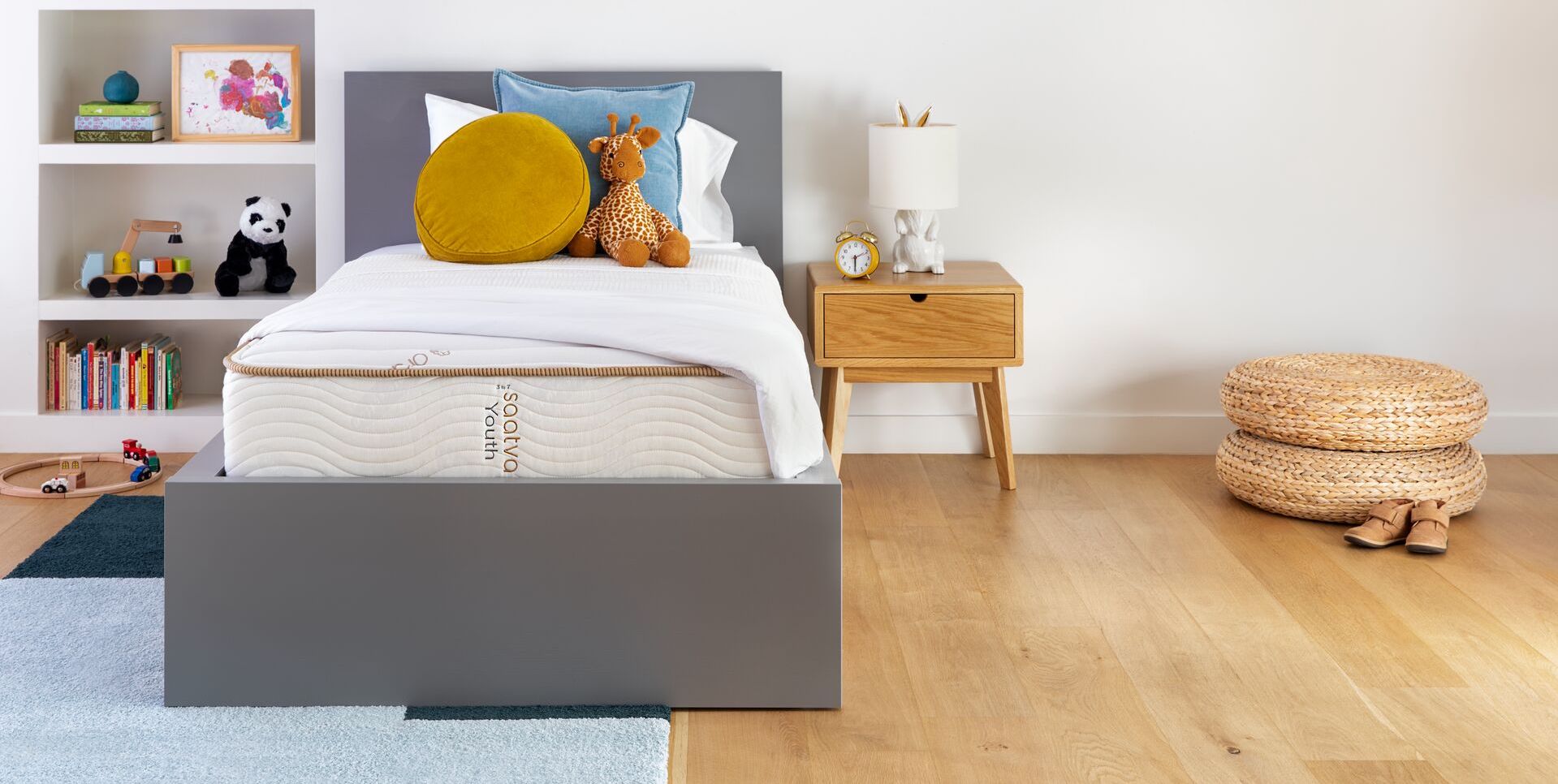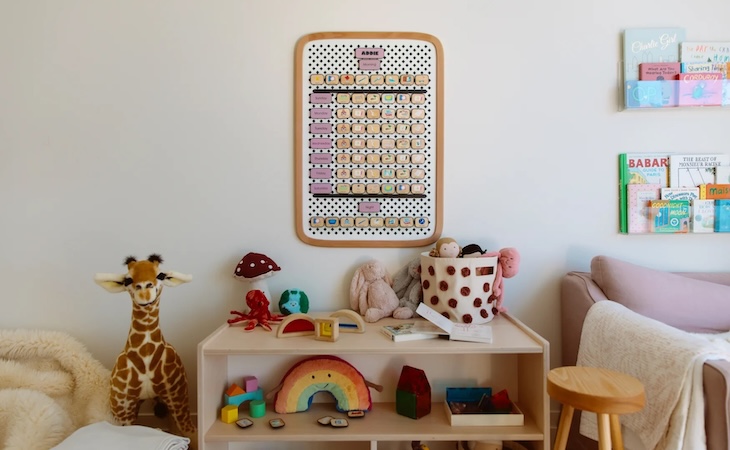After what has quite possibly been the quickest summer on record, a new school year is here. It’s hard to believe that this will be the second full school year we’ve started amidst pandemic life—and though school policies and schedules might vary pretty widely depending on where you live, one thing’s for certain: Getting your child(ren) into a solid back-to-school sleep routine has never felt so important.
The last year and a half have been nothing short of topsy-turvy for everyone—and that includes your little ones. So, if you’re having trouble getting them to stick to a regular bedtime routine these days, you’re far from alone.
How the pandemic has affected kids’ sleep
“The pandemic impacted kids’ sleep in two major ways,” shares Lynelle Schneeberg, PsyD, director of the Connecticut Children’s Medical Center Behavioral Sleep Program and author of Become Your Child’s Sleep Coach.
The first, she says, is children didn’t have to get up as early as usual to catch the bus or physically get to school. And the second? Many kids absorbed some of the worry and anxiety their parents experienced—and had trouble sleeping as a result.
Of course, though, research has shown time and time again that quality sleep is a nonnegotiable for kids’ growth and development—not to mention their behavior and performance in school and other activities.
The changes and inconsistency of the pandemic ultimately had many kids banking fewer hours of sleep, which is a recipe for irritability, behavioral problems, tantrums, and trouble focusing, Schneeberg says.
Whether you’re preparing to send your little nugget off to kindergarten or anticipating daily struggles with your high schooler, these expert-backed sleep tips will help you finally get your kids back into a regular routine after a summer off (and a year-plus of pandemic-related schedule disruptions).
Back-to-school sleep tips for children of all ages
While some sleepy-time strategies are better suited for young children than teenagers (and vice versa), there are a few general back-to-school sleep tips that all parents should keep in mind.
Adjust wake-up times gradually
Ideally, you’ll give yourself (and your children) at least two or three weeks to shift into back-to-school mode so you can make any necessary changes gradually and be settled into your bedtime and wake-up routines come that first day, Schneeberg says.
Since you can’t exactly train your kid to drift off into dreamland at the same moment each night, focus instead on what time they’ll wake up. “You can’t make a person fall asleep, but you can help them get up at a certain time,” Schneeberg says. “The rise [or wake-up] time is your anchor.”
If your little (or not-so-little) one will need to wake up at 7:15 a.m. for school but has been sleeping in until 9 a.m., bump their wake time up by about 30 minutes or so every few days—or each week, depending on how much time you have until school kicks off—to gradually get them there, suggests Schneeberg.
This gradual shift then helps kids feel sleepy earlier and earlier, reinforcing whatever bedtime routine you’re working on. (More on how to approach that part soon.)
Plan mornings wisely
To further reinforce those earlier wake-up times, Schneeberg recommends getting your children outside, giving them something to eat, and engaging them in some sort of light movement as soon as possible in the morning.
“These things tell your brain, ‘Oh, Susan needs to be awake now because light is flooding in and she’s eating and moving around,’” she explains. (The experts call this circadian entrainment.)
You might, for example, take your kids with you to grab the newspaper at the end of the driveway or let the dog out and then have some breakfast together.
Back-to-school sleep tips for young children
How you work on your young child’s bedtime routine differs pretty greatly from how you’ll try to wrangle a tween or teen into bed. For the little ones (think toddlers through grade school), a consistent and clear structure is a must, Schneeberg says.
Think “kitchen, bathroom, bedroom”
Though what your actual bedtime routine with your child looks like can vary, Schneeberg recommends following a specific formula: “Start in the kitchen, then move to the bathroom, and then wrap up in their bedroom,” she says.
If your little one has some sort of snack before bed, knock that out first. Otherwise, you lose the momentum of wanting to head toward bed, explains Schneeberg.
Try this flow: Give your child a bedtime snack, then wash up (using the toilet, taking a bath, and brushing teeth), and then hop into their bed with a book.
Make a sleep routine chart
The ultimate purpose of a bedtime routine is that the set of steps or activities you do make your kid sleepy, truly triggering drowsiness. To make this happen, though, you have to be incredibly consistent, which can be tricky with young children. They often try to derail the routine by asking for a second bedtime snack or to go back downstairs to hug the dog.
That’s where a sleep routine chart comes in, Schneeberg says. On this chart, you simply write down all of the pre-approved steps your child’s bedtime routine involves.
“This way, when your little guy says, ‘But I want to go have another snack,” you can just refer to the chart and point out that they’ve already had their snack—and that a second one isn’t part of the routine,” she explains. “This helps keep stalling and protest to a minimum so you can actually establish your routine.”
Try bedtime tickets
If your youngin’ still hems and haws when it comes time to finally settle down in bed (which is common!), Schneeberg recommends using bedtime tickets.
“After you read your books and say goodnight, your little one will come up with a million things they forgot,” she notes. “They’ll say they want the door open, they want you to look under the bed, they want water—anything.”
Bedtime tickets—which can be index cards you decorate or poker chips—are your simple way to manage those extra requests that stall bedtime.
“You can use these to say, ‘OK now, I can go get you some water but that’s going to cost a ticket,’” suggests Schneeberg. “If they need anything else, that’ll cost their other ticket.”
These external guide rails help to keep your munchkin from totally derailing their bedtime routine—without making you the bad guy.
Back-to-school sleep tips for tweens
As kids enter puberty and begin to establish more independence, how you approach a healthy bedtime and sleep routine needs to shift.
Put the phones away
No surprise here: Screens are the topic every parent struggles with most with their tweens. Technology use is a tricky one at any time of day—and it’s especially troublesome come bedtime.
“If their phone is in bed, anything negative that might be happening socially—whether it’s bullying or whatever—is happening right in bed with them,” Schneeberg says.
Her suggestion: Establish a family-wide policy on what happens with phones when it’s time to wind down.
“Some parents shut down the Wi-Fi at a certain time or have everyone charge their phones downstairs or away from the bedrooms at night,” she says.
The earlier you put these rules around bedtime phone use in place, the longer your tweens are likely to comply.
Find non-phone bedtime rituals
So, what’s your tween supposed to do when it’s time to hit the hay but they’re not quite ready to close your eyes? Reading is the ideal bedtime activity—and a Kindle, which feels like screen time, can be a great tool for older kids, says Schneeberg.
Otherwise, encouraging your tween to draw, write, or do another solo activity that they enjoy can help them establish a soothing, positive before-bed routine.
Be prepared for a later bedtime
If, around middle school or so, you notice your children staying up later or resisting earlier bedtimes, don’t stress about it.
“Right around puberty, the body starts to release melatonin—the sleep hormone—later at night,” Schneeberg explains. “So it really isn’t a choice that tweens (and teens) want to go to bed later.”
As long as you can maintain a consistent wake-up time that gets your kids to school on time, you’re in the clear.
Model good behavior
Research shows adolescents often mirror their parents’ sleep routines and habits. So if you want your tween to establish and maintain a healthy sleep pattern that works for them, you’d better model solid sleep hygiene yourself.
Turning off your phone and the TV 30 minutes before bed, settling down with a book in the evening, and sticking to the same sleep schedule during the week and on weekends are just a few ways you can set the standard for your kids.
Back-to-school sleep tips for teens
The older kids get, the harder it is to enforce a strict bedtime routine. By the time your children are teenagers, you’ll need to get creative—and work with them—to establish a back-to-school sleep routine that sticks.
Set the latest wake-up time possible
If your teen is struggling hard to get up bright and early, figuring out the latest they can reasonably wake up before school can help them get the sleep they need. You’ve got to be organized to make this work, though, cautions Schneeberg.
That means they’ve got to pack their lunch, pack their backpack, shower, and set out their clothes the night before so they can literally wake up, grab breakfast, and head out the door. Since teens naturally fall asleep and wake up later, this can make dealing with early school start times less of a struggle.
Try the “school plus two” rule
Maintaining some shred of consistency with your teens on the weekends also goes a long way in reducing the weekday sleep struggle bus.
“I use ‘school plus two’ to determine how late teens—who can sleep late—can snooze in on the weekends,” Schneeberg notes. Under this rule, if your teen usually gets up at 7 a.m. during the week, they can sleep in two extra hours (until 9 a.m.) on the weekends until you wake them up.
“Otherwise, they’re shifting their circadian rhythm and it’s like they’re traveling across time zones every weekend,” she explains. Minimizing this shift as much as possible will help teens get up when they need to throughout the school week.
To motivate sleepy teens to get up and out of bed on the weekends, make plans for Saturday and Sunday mornings whenever you can.
“Maybe you go on a hike near your house on Saturday mornings or go out for pancakes as a family on Sundays,” suggests Schneeberg.
Use a sleep tracker
If your word isn’t enough to convince your teen to get more than four hours of sleep per night, set them up with a fitness tracker or smartwatch that can monitor their sleep patterns.
“Then, even the teen can see the reality of their habits and say, ‘Wow, this really is chaotic,’” Schneeberg says. “Plus, many trackers these days offer feedback about whether you need more sleep or have low sleep quality, so the tech does some of the work for you.”
The WHOOP, for example, is famous for estimating how much sleep you need based on the activity and stress level of your day and drawing connections between your sleep and performance (a major incentive for student athletes).
For more ways to help your child get better sleep during the school year, check out our back-to-school gift guide full of snooze-enhancing products for kids.





